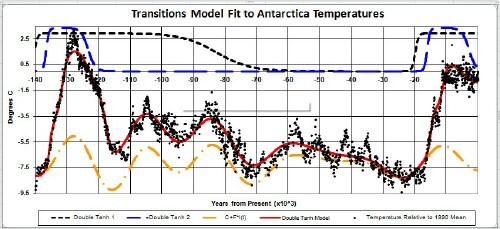
The time scale is 1000 years.
L. David Roper
http://www.roperld.com/personal/roperldavid.htm
6 April, 2016
The claim is often made that CO2-atmospheric-concentration change lags average-temperture change in the Antarctica ice-core data for the last four Major Ice Ages, including the Major Interglacials that separate the Major Ice Ages. Then the argument is often continued that change in CO2 atmospheric concentration does not change the average Earth temperature.
There seems to be a memory blocking of the fact that the Earth has a high-enough temperature for life because CO2 and other gases in the atmosphere trap heat and that laboratory experiments have shown that small CO2 concentrations trap heat by preventing infrared radiation from passing through.
The science of the mutual positive feedback between Earth temperature and atmospheric-CO2 concentration is well established. Two variables that have mutual positive feedback lead or lag each other depending on which one is first changed by some third variable on which it is dependent. Anytime one of the two variables is changed by some third variable changing it will cause the 2nd variable to change in the same direction; then the second changing causes the first to further change in that direction. If no other external variable intervenes to stop the positive feedback, a huge change in both variables can occur. This apparently is what is revealed in the 425,000 years of the Antarctica ice-core data. What is uncertain are the variables other than temperature and CO2 concentration that cause changes in temperature and CO2 concentration.
In this article I show that the Antarctica ice-core data do not give a clear picture of whether average temperature leads or lags CO2 concentration for the last four Major Ice Ages. Even if it did, it could not be read as a proof that dumping CO2 into the atmosphere does not change average Earth temperature.
I have done a good fit to the last four Major Ice Ages by using the summer solar insolation at the North Pole and two Earth states that turn on and off in the time region of the Major Interglacials. Here is a fit to the last Major Ice Age using this model:

The time scale is 1000 years.
Note that the dominant determinant of the temperature behavior between the Major Interglacials at both ends is the summer solar insolation [term C+F•I(t), the dotted yellow curve], especially near the end of the last Major Ice Age. So, in looking for correlations between average temperature and CO2 concentration, one should concentrate on the Major Interglacials instead of the entire ~110,000-year Major Ice Ages. (The insolation term has an affect during the Major Interglacials, which could cause the temperature to lead the CO2 concentration. And the two Earth states of unknown origin could also change the relative lead or lag of temperatue and CO2 concentration.)
The Earth-average-temperature and atmospheric-CO2 concentration from the Antarctica ice-cores are:
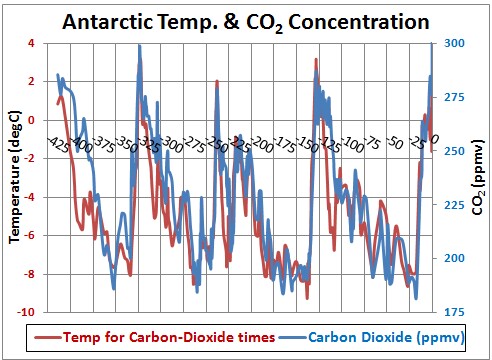
The time scale is 1000 years.
It is difficult to tell visually which of the two variables leads the other. Theoretically one expects then to change the lead-lag order with time as external forces intervene.
I divided the Last Major Interglacial (LMI), 2nd Last Major Interglacial (2LMI) and 3rd Last Major Interglacial (3LMI) into rising temperature/CO2 concentration and falling temperature/CO2 concentration to separately study leading/lagging correlations. For the Current Major Interglacial (CMI), of course, there are data only for the rise.
The results are:
The horizontal time axis is approximately in thousands of years. |
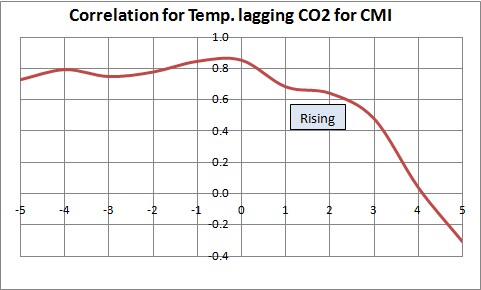 Temperature leads CO2 by about 200 years. |
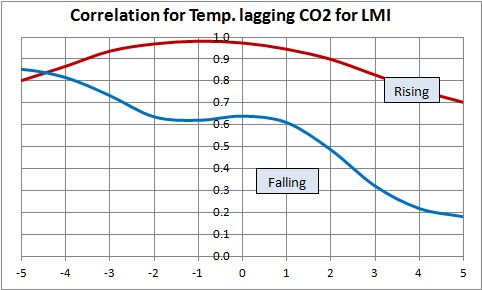 |
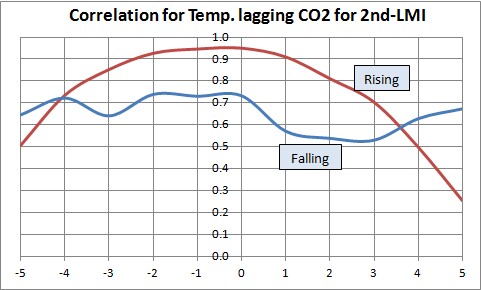 |
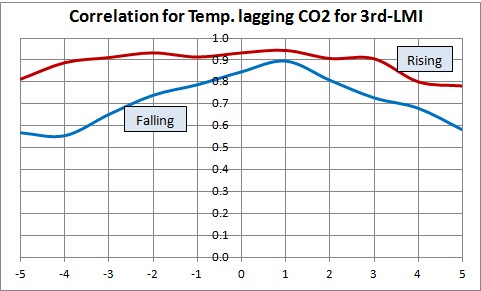 Temperature lags CO2 by about 1000 years for both rising and falling. |
It is not clear whether temperature leads or lags CO2 concentration. It becomes even less clear when all rises and falls are combined:
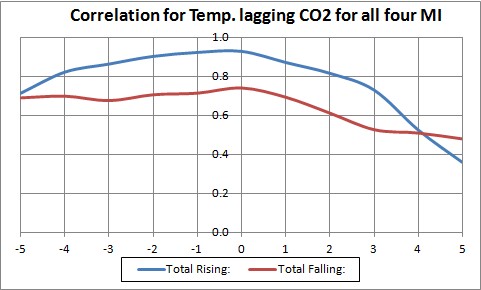
No discernable lead or lag between temperature and CO2 for falling data; perhaps a 100-years lag of temperature for rising data.
The Antarctica ice-core data for average temperature and CO2 concentration do not show a strong leading or lagging between the two variables. Even if it did, it could not be read as a proof that dumping CO2 into the atmosphere does not change average Earth temperature. Even in the time region of the Major Interglacials solar insolation would cause temperature to rise and it is uncertain as to the nature of the two Earth states that turn on and off.
Roper Global-Heating Web Pages
L. David Roper interdisciplinary studies